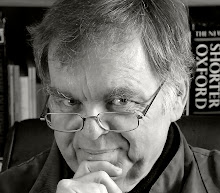Friday, October 22, 2010
But then again ...
Last time I railed against the zealot newbie photographers who have discovered prime lenses and taken to implying that zoom users should not be taken seriously in photography. These people really DO exist - I assure you. I was perusing some correspondence on a web forum from members of the "prime mafia" only this morning.
You'll recall I made the point that it didn't matter how sharp and clean the images produced with prime lenses were if the time and effort required to frame up a picture meant that the original inspiration had walked away. I also referred to the large apertures of fast prime lenses which made fast shutter speeds possible in low light. I suggested that this factor was not as important as once it might have been in the days of slow film emulsions because the latest DSLR bodies can produce usefully clean images at sensitivities of ISO 6400 or more.
In suggesting that "primes were past their prime" was I saying that there is no longer a place for prime lenses today? No. What I DID say was that I virtually never use prime lenses MYSELF anymore (for what that's worth of course). Being "past their prime" means to me that the period during which prime lenses were the glass of automatic choice now lies in the past. Back then, film was slow and zooms were pretty dreadful. Primes were truly in their prime.
In the 35mm film days EVERYBODY used 50mm prime lenses most of the time. I know I did. When the first DSLRs came along, the sensors were "APS-C" or "DX" size which was a somewhat cropped version of a 35mm frame. Consequently all of our beloved 50mm lenses became less generally useful because they became (in effect) short telephoto lenses. To make matters worse, some of them didn't always autofocus properly on the newest bodies. Manual focus was also less viable with digital bodies because they had removed our great film era focussing screens. So we pretty much all started using a generation of much improved ZOOM lenses and learned to make do.
Today, for most purposes, particularly photojournalism, sports coverage, general purpose vacationing, weddings & events shooting, birding, real estate, landscape and most on-location commercial shooting it is hard to go past zooms as the most readily suitable glass.
It has only been relatively recently that modern, fully autofocussing "normal" and "short telephoto prime lenses have again become available in any variety. I am the first to agree that for high quality studio set-ups, especially fine macro work and portraiture, prime lenses are a desirable choice and perhaps, once again, THE choice.
In my own case the arrival of the Nikkor 35mm f1.8 DX lens brings with it potential new horizons. It is a genuinely "normal" lens for the DX format. These days I run a couple of Nikon D80 (DX format) bodies with which I do occasional paying jobs - weddings among them. As sturdy, reliable and useful as the D80 is for now & then professional turns, it has always struggled (along with most bodies of its generation) to produce truly clean images at high ISO. When the powers that be prevent me from using flash during a wedding ceremony or when I am trying to cover (say) a choral festival in performance, I am usually left to get by as best I can with 1600 ISO under available light at a maximum f4. I have frequently had to manage with 1/30 second shutter speeds which is hardly ideal to say the least.
I could buy one of those super sensitive new bodies like the Nikon D3s of course but that's a lot of money and it may never really earn its keep.
Hopefully the 35mm f1.8 prime might give me a fraction more than two extra stops on my existing bodies. All other things being equal, my 1/30 second shutter speeds becomes a rather more viable 1/120 second. Of course I WILL have to perform gymnastics to get into good framing locations (I ain't as spry as I used to be, mate) given that the 35mm is only a normal lens. It IS very cheap however and a genuine bargain by all accounts. If I don't use it all that much I will have not wasted my investment. Now the 85mm f1.4 would be fantastic to cover theatrical events but it costs a lot of money too. I dunno.
Aaaanyway. Let me modify my assertions from last time. Are prime lenses past their prime? By definition, I have to say YES. Are primes dead and buried? Most certainly NOT!
Subscribe to:
Posts (Atom)
